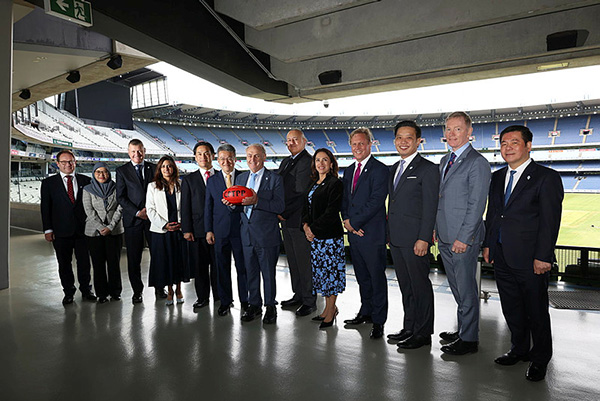Australia Chair of the CPTPP in 2025
On 1 January 2025, Australia assumed the Chair of the Comprehensive and Progressive Agreement for Trans-Pacific Partnership (CPTPP). Australia is committed to enhancing trade and economic opportunities for our Australian stakeholders and all CPTPP members, ensuring the agreement remains modern, effective, and responsive to global challenges.
Australia's theme for 2025 was Delivering Sustainable Trade and Resilient Growth and is focused on three overarching priorities:
- Increasing trade: leveraging the Agreement to further boost trade between members, bringing economic gains to our communities.
- Facilitating trade: we aim to make it easier for members to trade with each other by improving processes.
- Spreading the benefits of trade: Australia is committed to ensuring that CPTPP supports inclusive and sustainable trade practices.
As Chair, Australia drove meaningful outcomes that strengthen regional economic integration, increase trade and support sustainable and inclusive trade across the CPTPP membership.
On 21 November 2025, Ministers and representatives of the 12 CPTPP members participated in the Ninth CPTPP Commission meeting in Melbourne.
The Joint Ministerial Statement released by the Commission highlighted the work by the Membership to conclude the General Review and begin an accession process for Uruguay, and if appropriate, will commence accession processes with Indonesia, the Philippines and the United Arab Emirates in 2026. This will not prevent the consideration of other accession requests.
The Commission also released Joint Ministerial Statements for inaugural Trade and Investment Dialogues held with the Association of Southeast Asian Nations (ASEAN) and the European Union.
- CPTPP-ASEAN Trade and Investment Dialogue Joint Ministerial Statement
- CPTPP-EU Trade and Investment Dialogue Joint Ministerial Statement
The Birrarung Statement
In Naarm/Melbourne, Ministers and Representatives from Australia, New Zealand, Canada, Mexico, Singapore and Chile, issued the The Birrarung Statement. The Statement affirms our shared commitment to support greater participation in international trade and investment by Indigenous Peoples.
About the CPTPP
The CPTPP is a Free Trade Agreement (FTA) signed on 8 March 2018 in Santiago, Chile between Australia, Brunei Darussalam, Canada, Chile, Japan, Malaysia, Mexico, New Zealand, Peru, Singapore, and Vietnam. The United Kingdom (UK) signed its accession protocol to join CPTPP in July 2023. CPTPP entered into force for Australia, Canada, Japan, Mexico, New Zealand, and Singapore on 30 December 2018; 14 January 2019 for Vietnam; 19 September 2021 for Peru; 29 November 2022 for Malaysia; 21 February 2023 for Chile; 12 July 2023 for Brunei; and 15 December 2024 for the UK.
This Agreement is a separate treaty that incorporates, by reference, the provisions of the Trans-Pacific Partnership (TPP) Agreement (signed but not in force), with the exception of a limited set of suspended provisions.
Membership is open to other economies if they are able to meet the Agreement's high standards including a record of complying with international trade commitments and gain consensus support from CPTPP members.
CPTPP Establishment of Costa Rica Accession Working Group: Call for Submissions
On 28 November 2024, CPTPP Ministers agreed to the commencement of an accession process for Costa Rica.
The Department of Foreign Affairs and Trade (DFAT) invites submissions from interested individuals and groups on the commercial, economic, regional and other impacts of Costa Rica's potential accession to the CPTPP. The information stakeholders provide will assist the Government in considering Australia's accession negotiations with Costa Rica.
Individuals, organisations and groups that make submissions will be registered as stakeholders by the Department for further consultation and follow up, as appropriate.
Submissions can be lodged through: CPTPP@dfat.gov.au.
All submissions will be available on the DFAT website unless the author specifies otherwise.
Submissions received
- Australian Fair Trade & Investment Network (AFTINET) [PDF 370 KB]
- Business Council for Sustainable Development Australia (BCSDA) [PDF 438 KB]
Making the most of the CPTPP
The CPTPP recognises the challenges facing Small and Medium-sized Enterprises (SMEs) in establishing export markets, and includes outcomes to assist SEMs in the CPTPP region.
Other resources available include:
-
DFAT's FTA Portal
The FTA Portal is a comprehensive resource for exporters, and importers of goods and services looking to explore the benefits of Australia's current free trade agreements and how to apply for preferential treatment under those FTAs.
-
Guide to using CPTPP to export and import goods
This guide has detailed information about how you can make the most of the CPTPP including how to make sure your goods qualify for tariff cuts.
-
Certification of Origin
Under the CPTPP, an importer may make a claim for preferential tariff treatment based on a Certification of Origin (COO) completed by:
- an importer
- an exporter, or
- a producer
Unlike other FTAs, under CPTPP this certification does not need to follow a prescribed format, however it must be in writing (including electronic) and must contain a set of minimum data requirements. A template to help you meet these requirements is available here:
Attachment C: Guide to using CPTPP certification of origin for template example [DOCX]
-
FAQ
Other useful information includes:


